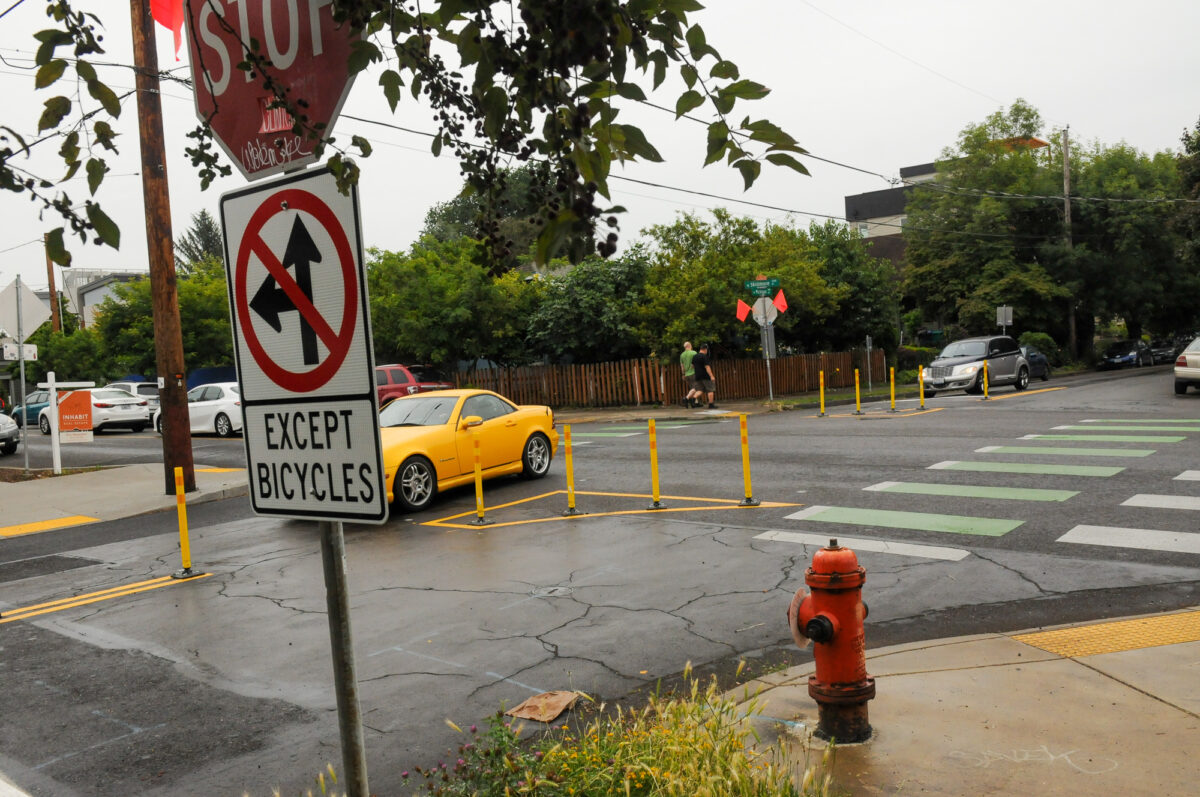
(Photo: J. Maus/BikePortland)
Making good on a promise made back in April, the Portland Bureau of Transportation has installed new plastic wands, signage, and striping at the intersection of North Michigan Avenue and Skidmore.
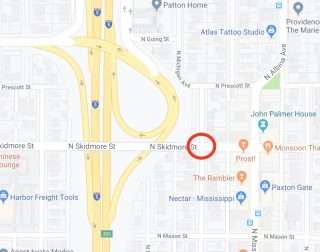
The project aims to reduce the amount of people who drive on Michigan, a neighborhood greenway that’s supposed to be a low-stress, family-friendly street where bikers and walkers have priority. As we reported three months ago, PBOT has concerns about the high volume of people driving on Michigan. And at Skidmore specifically, the rate of crashes also raised a red flag.
The new diverters prevent car users from crossing Skidmore on Michigan. As we’ve seen all over the network, PBOT wants people to drive on larger arterials and neighborhood collector streets (in this case Albina or Interstate/I-5) and stay off of neighborhood greenways unless it’s their final destination.
This project is relatively simple: 10 plastic wands, “No Turn Except Bicycles” signs, and some clever pavement striping force people to turn right off of Michigan. At least that’s the intention.
Advertisement
Everyone seems to be blowing through this diverter at Michigan and skidmore @PBOTinfo pic.twitter.com/blkstEafNe
— Steve ⛱ (@Intersection911) July 9, 2019
Unfortunately, the design isn’t robust enough to deter some selfish, scofflaw drivers (as seen in the tweet above). During my 10 minutes at the intersection yesterday I saw three drivers ignore the diverters and illegally continue straight through the intersection. I saw far many others obey the signs and do the right thing. Hopefully compliance improves as time goes on. If not, PBOT will need to come back and tweak the design.
“I think PBOT should be presenting that as a choice: ‘Do you want to see traffic impacted? Or do you want to see parking removed and put in bike lanes?'”
— Reza Farhoodi, Bicycle Advisory Committee member
At the City of Portland’s Bicycle Advisory Committee meeting last night, PBOT Neighborhood Greenway Coordinator Scott Cohen asked committee members what they’d like to see on greenways. “Diversion by default” — that is, installing diverters as standard practice, without asking permission and/or without waiting for complaints or conditions to worsen — was the top response.
Diverters have broad support among safe streets advocates. But for PBOT, the mere mention of the term often sends shivers up project managers’ spines. The agency fears backlash from people who think diverters make driving inconvenient and will only lead to more drivers on adjacent streets.
In 2011, PBOT wanted to install a diverter a few blocks north of Skidmore at Michigan and Rosa Parks. But because a few local residents objected, the project — and its benefits to public health and safety — was delayed for over a year.
Thankfully, PBOT has made great strides to overcome their diversion aversion in recent years.
At the BAC meeting last night, Cohen seemed supportive of calls for “diversion by default,” but he was clearly not ready to adopt such a policy. To do that, he said PBOT would need stronger political footing. Some sort of greenway action plan with diversion by default included as an action item would need to be adopted by City Council in order to give PBOT more authority.
Committee member Reza Farhoodi suggested to Cohen that PBOT might find more support for diverters if they told people who oppose it that the other option is a dedicated bike lane. “I think PBOT should be presenting that as a choice: ‘Do you want to see traffic impacted? Or do you want to see parking removed and put in bike lanes?'”
— Jonathan Maus: (503) 706-8804, @jonathan_maus on Twitter and jonathan@bikeportland.org
Never miss a story. Sign-up for the daily BP Headlines email.
BikePortland needs your support.

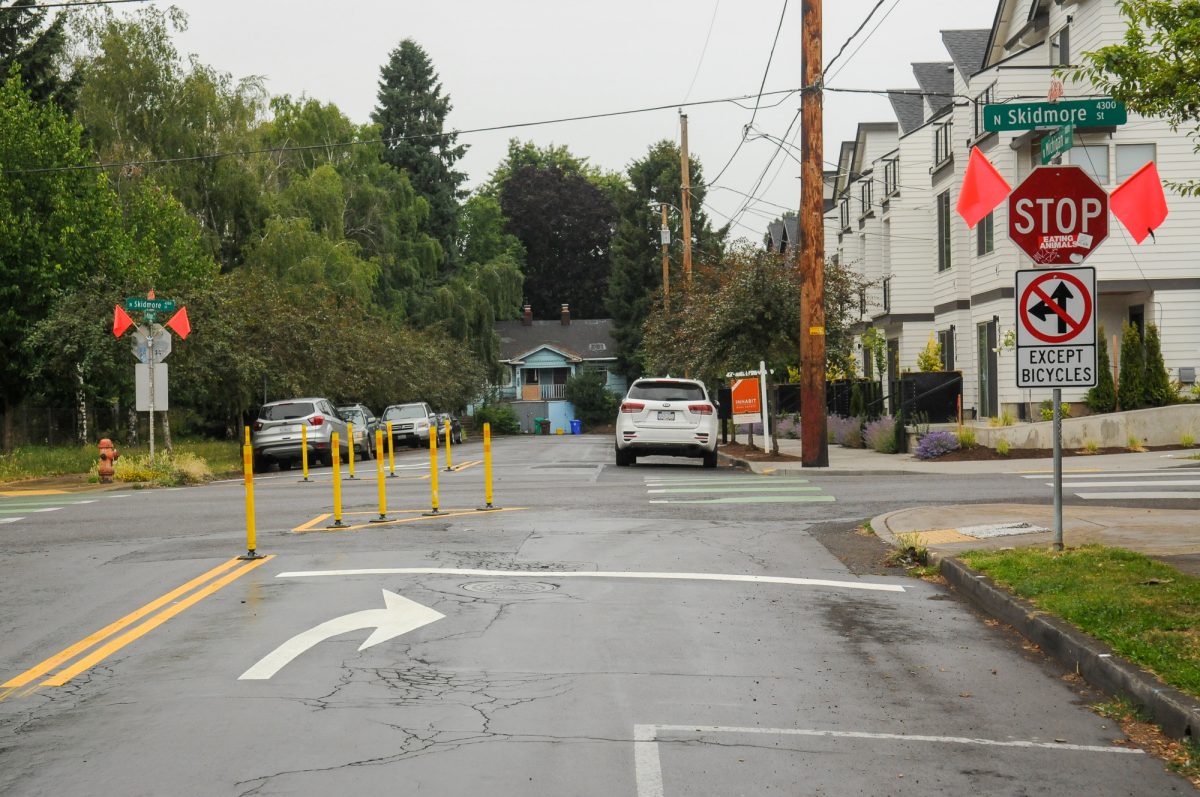

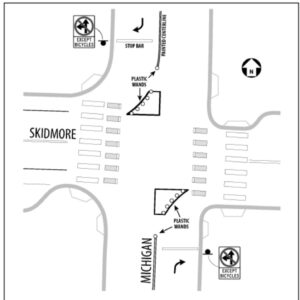


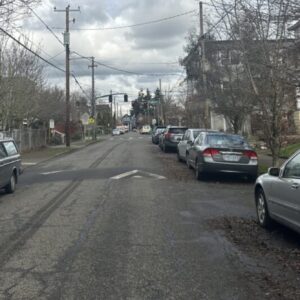
Thanks for reading.
BikePortland has served this community with independent community journalism since 2005. We rely on subscriptions from readers like you to survive. Your financial support is vital in keeping this valuable resource alive and well.
Please subscribe today to strengthen and expand our work.
I can only smile wryly when I read that “At the BAC meeting last night, Cohen seemed supportive of calls for “diversion by default,” but he was clearly not ready to adopt such a policy. To do that, he said PBOT would need stronger political footing.” when my frame of reference is that all greenways in Portland should be car free (or cars as visitors because yes, grandfathered residents should be able to park a car in their driveway). If diversion is too touchy, we are so far away from where we need to be.
Even with frequent diversion, a block is never and never intended to be car-free. It’s just that those poor drivers, at great personal cost, would have to go another couple of blocks. Diversion up to every other block would be great – tough for cars to build up any speed.
How many citations have been issued by PPB to motorists for violating a diversion instruction or driving in a bike lane? Has there ever been one?
I know that PPB has set up shop on Willamette after the diversions were put in.
I wish I was at the BAC yesterday–I missed the last two meetings. I would have echoed the sentiment of diverters by default!
I’ve had the pleasure of emailing Scott Cohen about diverters by default. I have always appreciated his responsiveness and candor about talking bike infrastructure. He seems like a great guy and I am know he echoes a lot our sentiments about greenways. In my conversations with him, I have often advocated for the use of diverters over the speedbumps that seem to come standard with every implementation of a bike greenway.
I often wonder why we implement speedbumps by default on bike greenways when anyone who has ever been on a bike knows how annoying they to ride over. Speaking with Roger Geller after one BAC meeting, he even mentioned how in the Netherlands the smoothness of a road is another standard used to design low stress bikeways. If we ignored the potholed concrete mess of some of our current bikeways, how does having speedbumps on bikeways contribute to the smooth, stress-free ride of a cyclist? My point is: speedbumps, which seem to be put in place by default on bike greenways, or antithetical to low-stress experiences valued by cyclists.
You can make the argument that speedbumps on bike greenways slow cars down, but then I’d argue the name bike greenway is a misnomer: It is not intended to help facilitate bike traffic, but rather allow privileged residents to ensure their street doesn’t become a speedway. This also leads to a cyclist’s presence on a greenway as a human shield for PBOT–a cyclists is encouraged to use a greenway not because they are intent on making seamless and intuitive connections, but rather as another obstacle that is supposed to slow motorists down. I’m not interested in seeing PBOT seeing cyclists as a tool to slow traffic as it can lead to a dangerous situation and relies heavily on driver attentiveness. But currently, that is the impression I get from riding on a bike greenway.
Ultimately, if we want to make bike-greenways for bikes, let’s discourage motor vehicle traffic from traveling long distances or getting up to speed on them by using diverters. And lets get rid of the speedbumps that make for a choppy ride on the bike, we all know these greenways are already on some of the hilliest and uneven terrain as it is!
I hope PBOT is listening and has the courage to support this! I will do what I can if needed to make this a permanent policy!
I wouldn’t mind some bypasses though the speed bumps, TBH. Not close or wide enough to drive over, but enough not to break my rhythm on skinny road bike tires and especially with cargo going uphill.
Diverters—not just by default, but everywhere! It is high time for PBOT to catch up to the fact that smartphones have made every street a through street (practically a dragstrip in my case.)
Don’t forget @Champs…bike streets often have the stops signs flipped…ensuring cyclists don’t have to stop at every interesection. This however, also makes it appealing for cars to use the bikeway as they don’t have to stop as often as well!
There’s been at least one; my coworker got one on N. Willamette Blvd.
I really wish I could have gone, but had a conflict. A group of us have been working on this policy for years, including having a meeting at PBOT with key players about six months back where the response was “You are not wrong, but a policy like this would need to go to Council and have a public process, let us wait until we hire a Greenway coordinator.”
I’m happy PBOT is taking this policy seriously. As someone who helps lead the largest Neighborhood coalition, we need a standard policy to pull these individual diversion fights out of the Neighborhood. In her last campaign, Sarah Iannarone expressed support for this policy, in writing and verbally as this was policy question from the BikeWalkVote PAC.
Speed humps signal that a car can use this road, but must go slow. It’s not an indication of priority at all. And oftentimes people fly over speed humps in general as many don’t care or know about the impact on the wheels or suspension when traveling fast. (as most people are not trained in driving or automotive knowledge to know this).
I tend to agree with Champs regarding the feeling of ‘breaking the rhythm.’ The same principle that affects cars affects bikes, but with our lack of suspension (in general) i’d say it affects cyclists 10x as much. I’d much rather a bikeway with diverters every few blocks and smooth surface than speed humps on a bikeway.
Sorry I should clarify on my last statement:
“I’d much rather a bikeway with diverters every few blocks and smooth surface than speed humps on a bikeway.”
It’s not an either/or situation. And speed humps with wide enough cutouts for bikes are fine by me. I’m just not super enthusiastic; I do think they slow motorists down, but I don’t think they are bike-friendly as PBOT would like you to believe.
In Portland there seems to be a correlation between rough pavement and future installation of a greenway but we’re about 8000 km from the Netherlands. You could almost say it’s a difference of night and day!
Put me down for diverters, no speedbumps. Also, outlet diverters are too easy for MV operaters to game. The old school diverter at NE 16th and Tillamook is good, and the concrete planter diverter on NE Rodney seems to work pretty well too.
Isn’t the term ” selfish, scofflaw drivers ” redundant?
Thought I’d offer a counterpoint, I don’t find the speed humps at all inconvenient or uncomfortable on a bike, no matter the speed or tire width, not even at high speeds like on Germantown.
Hi Jeff thanks for your opinion–maybe my opinion was not as universal as I’d thought. Speed humps are not the hill I want to die on–and if others are fine with it or enjoy having them, it looks like the new humps with cutouts are a good compromise.
If given a choice, I would vastly prefer diverters over speed humps to increase my enjoyment of bike greenways and discourage cars from using the greenways and limiting travel on them enough to speed.
We can definitely agree on that – more diverters means less need to turn stop signs which means less need to control vehicle speed.
My preferred greenway would have smooth pavement and diverters without speed humps. If speed humps are included, I strongly prefer them without any groove to bike through. The grooves tend to be too narrow adn I get pedal strikes when riding my touring bike. Also, the side slopes can be tough to negotiate if you don’t see it coming – this has happened to me on dark, rainy nights, and when I am sandwiched between cars and don’t have great visibility, like on 28th. Also, on 28th, the grooves are placed so that to use them, you have to ride in the door zone of the parked cars. In my experience, rolling over a hump is no big deal and fairly safe/easy on a bike, the groove added for bikes introduces a lot of potential for dangerous situations.
Ditto to everything that MaxD just said. I agree with you, Shimran George, speed bumps are not the hill we want to die on. To quote my friend, Bruce, “Speed bumps: get over them.“
The southeast Clinton Greenway has been the first place for PBOT to test their so-called bicycle-friendly speed bumps with channels for bicycles. Right. If you see channels elsewhere, they are for other vehicles, like firetrucks. The feedback I wrote on those in November 2018 is below. Please check them out when you get a chance and let PBOT’s Scott Batson know what you think. Otherwise, this could be what we get installed everywhere.
11/20/18
Here is my input now that I have had time to give them a fair test.
1. I ride through these speed bumps approximately 8-12 times per week. I have forced myself to ride in the channels many times to give it a good chance. Often I just can’t do it because it doesn’t feel safe. The channels are too long and narrow for me to hold a steady line, especially when I am traveling uphill more slowly and therefore more wobbly. In some spots the width of the channel is uneven, narrower than the 12″ designed. I think if the channels were significantly wider I likely would use them.
2. I believe I saw a PBOT comment somewhere that said they came out and observed that “the overwhelming majority” of bicyclists are riding through the channels. This is not consistent with my observations. I haven’t had time to go down and video-document the usage, but last night as I was riding eastbound on Clinton and made a count. Of the 19 cyclists who passed me, 5 rode through the channels and 14 rode over the speed bumps. If I had an electric assist I would have caught up to them and asked why, but they were all too fast for me.
3. I’ve observed something that did not previously occur to me. The channels are installed in the middle of each travel lane which seems right as that is where cyclists should be riding and they should not be forced off-line-of-travel to take the channels. However, as long as many drivers continue to insist on creating a third lane down the middle of Clinton in order to pass cyclists even when there is also an oncoming cyclist, the cyclists traveling in both directions are forced out of their travel lane and off to the side of the channels.
4. Riding over the top of the speed bumps doesn’t bother me. I do understand that some cyclists do not like riding over speed bumps, but I’m wondering what the percent breakdown would be. For me, riding surface is an important issue, but I would rather focus on areas of our network that have an excessively poor surface. After Ted Wheeler’s public bike ride to work, that pavement coming off the Hawthorne Bridge up to SW 2nd got fixed. I’ll nominate two other spots by way of example: 1. The messed up concrete on the 42nd Ave bikeway between SE Taylor and Belmont is over the top, especially for a designated bike route. UPDATE 7/10/19: We now have nice smooth asphalt they’ve installed in the last month. Thank you, PBOT! We don’t thank them enough when things get fixed. 2. The washboard ruining the newly repaved section of SE Caruthers between Grand Ave and the start of Tilikum Way at 7th should be ordered repaired by the private party who damaged it: the construction company that built the Extra Space Storage building at 685 SE Division Pl.
5. Many people have referenced the channels in the speed bumps on NE 28th north of Burnside. Scott Batson keeps reminding us that they are for fire trucks, not bikes, and that they were installed incorrectly by a private contractor. They are a significant hazard to cyclists and should be removed or corrected ASAP before someone is seriously hurt by them. It is bad enough not to repair damage on road surfaces, but to install something that is so hazardous is crazy. And where is the shepherding of our tax dollars on this? The private contractor should be held accountable for the repair or removal of these channels, and we taxpayers should not be financially vulnerable to a lawsuit that could be rightfully brought against the City for installing and allowing a known hazard to remain.
UPDATE 7/10/19: Many of the channels now have uneven edges and crumbling asphalt. This exacerbates the hazard.
Betsy
The corner of Michigan and Skidmore is on my daily commute. Since installed, I haven’t seen a single driver mind the sign and diverters. They just go around. Here’s an idea: occasional enforcement.
I think of it like the 20mph signs along Knott and the green box/no right on red at MLK & Russell (also on my commute & often ignored). Those who were already aware and driving responsibly mind the signs and try to drive even more carefully. But the real problem drivers are those that continue to disregard signs (or those fancy new thingies in their way).
“PBOT wants people to drive on larger arterials and neighborhood collector streets”
And yet PBOT has done nothing to provide for adequate capacity on said streets.
Ex-act-ly! That’s the point. Make driving as difficult and inconvenient as possible so that people make as few trips as possible and so as many people as possible choose to use a different mode.
Our streets have more than enough capacity for cars.
Like I’ve commented before on at least one other article: there are a lot of drivers who do not pay attention to just about any signs or paint. I don’t know if PBOT actually expects honor system diverters to work. I rode through this recently but I didn’t hang around to watch anyone driving interact with it.
And while we are at it, remove car parking on Skidmore from Mississippi to MLK and put in some bike lanes. That street can be a real headache and it’s a pretty good east/west connector to get to the Going greenway. Turns out these apartment dwellers really love their cars.
I do wish Portland’s Greenways would include more explicit traffic calming infrastructure, both to make life better for cyclists, but also to shift the conversation to being about making neighbourhoods places for people and not cars. Here in Vancouver, BC (where I live part-time) there are Traffic Calmed signs installed when you turn off arterials into neighbourhood streets, and lots of diversions that only matter if you don’t live in the area. They serve the purpose of making the neighbourhood bikeways very unappealing to cars, but also of making cut through traffic unappealing/nearly impossible.
Here is one of my favourites, a bike only pass through turned garden plot (make it pretty and people will love it): https://goo.gl/maps/ukBrAKvLKAfoyBeP6
And a block away, a less pretty but very robust car diversion (note: wands are metal and concrete is poured, no plastic & paint here): https://goo.gl/maps/xL43BTgQPEigKwwr6
I still don’t see a stop sign for traffic on Skidmore at this intersection. Until the cars on Skidmore have to stop at Michigan, this intersection will never be safe imho. I stopped going through that intersection, opting for Failing Street overpass instead, due to the wait to cross Skidmore and the dangerous speed of the cross traffic.